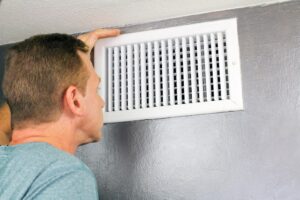Your daily habits affect the air you and your family breathe in Saylorsburg, PA, more than you probably realize. One especially problematic culprit takes the form of volatile organic compounds (VOCs). In this article, we’ll explain the dangers of VOCs, where they can be found in your home and how to eliminate them.
What Are Volatile Organic Compounds (VOCs)?
VOCs are gases that discharge from dyes, drugs, cleaning agents and coolants. They commonly affect the air quality in a house.
These pollutants come from everyday household items you probably use regularly. Contaminant amounts add up quickly if you don’t consider the products you use and the ventilation in your home.
Common household products that can release VOCs in the air include:
- Paint
- Insulation
- Cleaning products
- Burning wood
- Hairspray
- Cigarettes
Many of these items seem innocuous enough, especially if they’re in small doses. However, some products create more harm than others.
Dangers of VOCs
The dangers of VOCs depend on a number of variables, including the specific VOCs in the air, their concentrations, ventilation and each person’s health. High concentrations of chemicals in the air that your household breathes can definitely lead to medical issues, though, so VOC levels in your home deserve your attention.
People may not show any noticeable signs of health problems, while others may develop treatable short-term health problems or even long-term conditions that will cause issues for the rest of their life. Common short-term health problems that develop as a result of high concentrations of VOCs in the air include:
- Sinus irritation
- Eye irritation
- Stomach irritation
- Asthma
Common long-term conditions that people get from long term exposure to VOCs include:
- Organ failure
- Cancer
- Nervous system conditions
How to Reduce VOC Levels in the Air
Take action by avoiding VOCs to improve air quality in your home. Try these tips to reduce VOC contaminants in the air in your home.
Use Natural Cleansers
Most cleaning products contain chemicals that emit VOCs. Replace those products with 100% natural cleansers.
You can buy natural home cleaning products at the store or even make your own. The main ingredients usually include baking soda, vinegar, hydrogen peroxide and lemon juice.
Promote Proper Ventilation
When air can travel, the contaminants in the air will dissipate along the way. This becomes especially effective if you create ventilation that sucks out the air in your home and replaces it with fresh air from outside.
Get your HVAC system properly maintained before you use it to cool or heat your home, especially if you want to reduce contamination levels. A professional HVAC technician will clean the outdoor condenser, the indoor evaporator and the filter.
Another part of HVAC maintenance services involves cleaning the ducts in your home. Afterward, the air will travel through your home with ease and maintain high quality levels.
Choose Furniture and Paint Thoughtfully
When you plan to change things up with your decor, you probably don’t think about how your decisions will affect your air quality levels. You can always make purchasing decisions more consciously from here on out.
Buy paint with zero toxins. You also need to be wary of treatments manufacturers use on new furniture.
Check Air Quality Regularly
How do you know if your efforts are paying off? Test the air in your home regularly.
You can purchase home-testing kits or hire professionals to do the job more thoroughly. Continue to make adjustments until you have air quality levels that make you feel comfortable.
We all rely on certain comforts. When appliances fail you, or you’re interested in air quality products, call our team at Sullivan Oil and Propane to request heating and cooling services in Saylorsburg, PA, from a local company you can trust. Our expert technicians are happy to help.
Image provided by iStock



